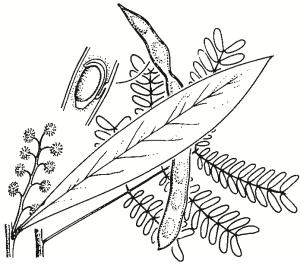Family:
Fabaceae
Acacia rubida
Red-stemmed Wattle
Other Names: Red-leaved Wattle, Red-stem wattle.

Name Origin:
rubida — from Latin ruber, red, referring to red stems.
Regional Subspecies:
Similar Species:
May resemble Hickory Wattle/Lightwood (Acacia implexa). Distinguish by reddish tinge in ‘leaves’ as they dry, and by retention of bipinnate foliage.
Occurrence:
Regional:
Noted in the Murray catchment, from as far west as Long Plain-West Hume, to as far east as Coppabella.
Australia:
Qld, NSW, Vic.
Habitat:
Usually dry sclerophyll forest on elevated rocky localities. Also riverbanks and swamp edges.
Habit:
Erect or spreading shrub or small tree 2-10 m high with brownish, finely fissured bark and ‘leaves’ 5-20 cm long.
Site Preference:
Dry soils. Tolerates frost, drought and limited waterlogging. Semi-shade and full sun.
Characteristics:
Very hardy and fast-growing. Juvenile bipinnate leaves persist on plant with adult ‘leaves’, up to 2 m high.
Flowering:
Pale to golden-yellow, Jul-Nov.
Seed Collection:
Early Nov to late Dec.
Propagation:
From scarified seed. Pour boiling water over seeds and soak for several hours before drying and sowing.
Regeneration:
From seed and suckers, particularly after fire.
VALUES:
Shade & Shelter:
Useful low-level cover in windbreaks.
Land Protection:
Useful for controlling soil erosion due to suckering and soil-binding fibrous roots. Legume — improves soil fertility by ‘fixing’ nitrogen.
Wildlife:
Flowers are a pollen source for native moths, butterflies and other insects. Insect-eating birds attracted. Seed-eating birds attracted, including parrots and native pigeons. Foliage good cover for small birds.
Ornamental:
Valuable ornamental, particularly conspicuous during winter when reddish. Severe pruning after flowering benefits plants.
